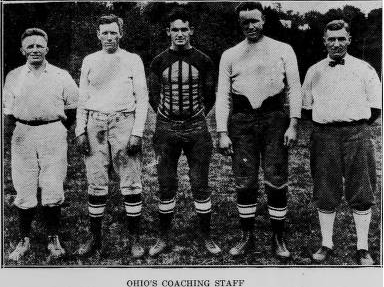Landing Page
Special Projects
This story is part of a series of specially designed stories that represents some of the best journalism The Post has to offer. Check out the rest of the special projects here.


Photo provided via Mahn Center for Archives & Special Collections
Ohio football’s coaching staff in 1924. Homecoming that year featured rain and snow, a 14-7 loss to Denison and a feast.
10.05.17
Ninety years before Ohio University students and alumni will pull out their phones to take selfies, photos and videos at Homecoming this Saturday, OU produced its first movie.
At Homecoming in 1927, the festivities were filmed and turned into a movie titled “Chronicles of the Day.” The film detailed events over the course of the day, including the Ohio vs. Wittenberg football game and the display of parade floats.
Unlike today’s banners that mainly show organization’s names, floats displayed different elements of college life, football score predictions and the spirit of homecoming, according to a Oct. 25, 1927, Green and White report. The Green and White later became The Post.
Some floats from that year included one that represented the football field and team and another that displayed a cow and read “This is no bull, we’re going to win the game.”
In addition to traditions such as floats and parades, Homecoming celebrations of the 1920s were littered with football wins over Cincinnati.
In 1926, the “Pedenmen” defeated Cincinnati 38-7, and the band formed a human OU in the center of the field.
“Ohio’s Bobcats, inspired by a crowd of 4,000 present for the annual Homecoming and Dad’s Day event, tore the hides off the previously ferocious Cincinnati Bear Cats and sent them back to the Queen City looking like a pack of whipped alley cats,” reads an Oct. 26, 1926, Green and White report.
Scoring began in the first quarter, and later in the game coach Don Peden pulled his starters and replaced them with his second- and third-string players.
An even bigger blowout came a couple years later in 1928, when the Bobcats shut out the Bearcats 65-0 in front of a crowd of about 5,000.
After the Bobcats scored early and often, Peden, as he did two years before, substituted in his second- and third-string men during the matchup.
“Against the second and third string men the Bearcats were just as helpless, and had it been possible, the frosh gridders might have had a chance at the Bearcats,” reads an Oct. 23, 1928, Green and White report.
“ ‘Get that umbrella down’ became as popular a chant as ‘we want a touchdown,’ ” reads a Nov. 5, 1929, Green and White report
A year later, Ohio defeated rival Miami 14-0 in a rainy match and remained the only unbeaten team in the state.
“The water didn’t scare them — it just made them fighting mad,” reads a Nov. 5, 1929, Green and White report.
Thunder could be heard from both the sky and the stands, according to the report. About 8,000 people attended the game.
“ ‘Get that umbrella down’ became as popular a chant as ‘we want a touchdown,’ ” reads the report.
The game also served as a dedication to a the new stadium, which cost $185,000.
Other Homecoming celebrations took various forms throughout the decade. In 1924, rain and snow couldn’t dampen the festivities, which featured 90 gallons of steaming burgoo, which is a spicy stew, and a thousand pounds of roast ox.
“All doubts as to the right of the southern barbecues to fame, disappeared with a rapidity rivaled only by that of the delicious sandwiches, olives and stew,” reads a Nov. 21, 1924, Green and White report.
In 1921, a Homecoming celebrated both alumni and the inauguration of OU’s 10th president, Elmer Burritt Bryan. Each class gave a skit, and students assembled in a “monster parade” that traveled from Court Street to Ohio Field, where there was an immense bonfire.
A Nov. 11, 1921, Green and White report described the events as a genuine “Whiz Bang.” During that year’s homecoming game, Ohio beat Cincinnati 7-6 in what a Green and White report referred to as a “thrill producer” for alumni and a “fitting climax” to Homecoming festivities.
Landing Page
This story is part of a series of specially designed stories that represents some of the best journalism The Post has to offer. Check out the rest of the special projects here.